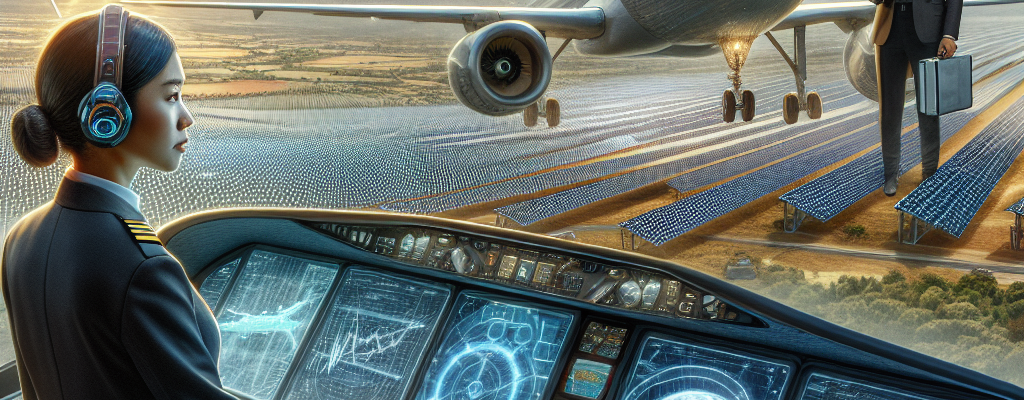“Embracing the Future: Unveiling the Revolutionary Trends in Aviation for 2024” Introduction In 2024, the aviation industry is expected to witness several significant trends that will shape the future of air travel. These trends encompass various aspects, including technological advancements, sustainability efforts, changing passenger expectations, and evolving regulations. As the industry continues to evolve, these trends will play a crucial role in shaping the aviation landscape in 2024 and beyond. Emerging Technologies Shaping the Future of Aviation The aviation industry has always been at the forefront of technological advancements, and 2024 is no exception. As we look ahead to the future of aviation, it is clear that emerging technologies will play a significant role in shaping the industry. From electric aircraft to autonomous systems, these innovations are set to revolutionize the way we fly. One of the most exciting trends in aviation is the development of electric aircraft. With concerns about climate change and the need to reduce carbon emissions, electric planes offer a greener alternative to traditional jet engines. These aircraft are powered by electric motors, which are more efficient and produce zero emissions. Not only do electric planes have the potential to reduce our carbon footprint, but they also have the advantage of being quieter, making them more environmentally friendly and less disruptive to communities near airports. Another emerging technology that is set to transform aviation is autonomous systems. While fully autonomous passenger planes may still be a few years away, the use of autonomous systems in aviation is already becoming a reality. Drones, for example, are being used for various purposes, such as aerial photography, package delivery, and even search and rescue missions. These unmanned aircraft are controlled remotely or operate autonomously, using advanced sensors and artificial intelligence to navigate and avoid obstacles. As the technology continues to advance, we can expect to see more autonomous systems being integrated into commercial aviation, improving safety and efficiency. In addition to electric aircraft and autonomous systems, virtual reality (VR) and augmented reality (AR) are also making their way into the aviation industry. VR and AR technologies have the potential to enhance pilot training, maintenance procedures, and even passenger experiences. For pilots, VR can provide realistic simulations of various flight scenarios, allowing them to practice and improve their skills in a safe and controlled environment. Maintenance technicians can use AR to overlay digital information onto physical aircraft components, making it easier to identify and fix issues. Passengers, on the other hand, can enjoy immersive entertainment experiences during their flights, thanks to VR headsets and AR applications. Furthermore, the use of big data and analytics is becoming increasingly prevalent in aviation. Airlines and airports are collecting vast amounts of data, ranging from passenger preferences to aircraft performance. By analyzing this data, airlines can optimize flight routes, improve fuel efficiency, and enhance the overall passenger experience. For example, airlines can use predictive analytics to anticipate maintenance needs, reducing the risk of unexpected delays or cancellations. Additionally, airports can use data analytics to optimize security procedures, reducing wait times and improving the flow of passengers through the terminal. As we look ahead to 2024 and beyond, it is clear that emerging technologies will continue to shape the future of aviation. From electric aircraft to autonomous systems, VR and AR, and big data analytics, these innovations are set to revolutionize the way we fly. Not only will these technologies make air travel more sustainable and efficient, but they will also enhance safety and improve the overall passenger experience. So buckle up and get ready for an exciting future in aviation! Sustainable Aviation: Innovations and Initiatives The aviation industry has always been at the forefront of innovation, constantly pushing the boundaries of what is possible. As we look ahead to 2024, it is clear that sustainability will be a key focus for the industry. Airlines and aircraft manufacturers are taking significant steps to reduce their environmental impact and create a more sustainable future for aviation. One of the most exciting trends in sustainable aviation is the development of electric aircraft. These planes are powered by electric motors, eliminating the need for traditional jet fuel. Not only do electric aircraft produce zero emissions during flight, but they are also quieter and more energy-efficient. Several companies are already working on electric aircraft prototypes, and it is expected that we will see commercial electric flights within the next few years. In addition to electric aircraft, airlines are also investing in sustainable aviation fuels (SAFs). These fuels are made from renewable sources such as plant-based materials or waste products, and they have the potential to significantly reduce carbon emissions. Many airlines have already started using SAFs on select flights, and the hope is that by 2024, these fuels will be more widely available and affordable. Another important initiative in sustainable aviation is the reduction of single-use plastics. Airlines are taking steps to eliminate plastic straws, stirrers, and cutlery from their flights, opting for more sustainable alternatives. Some airlines have even started experimenting with edible cutlery made from materials like wheat or rice, further reducing waste. By 2024, it is expected that single-use plastics will be a thing of the past in the aviation industry. Furthermore, airports are also playing a crucial role in promoting sustainability. Many airports have implemented energy-efficient measures such as solar panels and LED lighting to reduce their carbon footprint. Additionally, airports are investing in electric ground support equipment, such as baggage tugs and aircraft loaders, to reduce emissions on the ground. By embracing sustainable practices, airports are not only reducing their environmental impact but also setting an example for other industries. The push for sustainability in aviation is not limited to technological advancements. Airlines are also focusing on reducing their overall carbon footprint through initiatives such as carbon offset programs. These programs allow passengers to voluntarily offset the carbon emissions from their flights by investing in projects that reduce greenhouse gas emissions elsewhere. By 2024, it is expected that carbon offset programs will be

